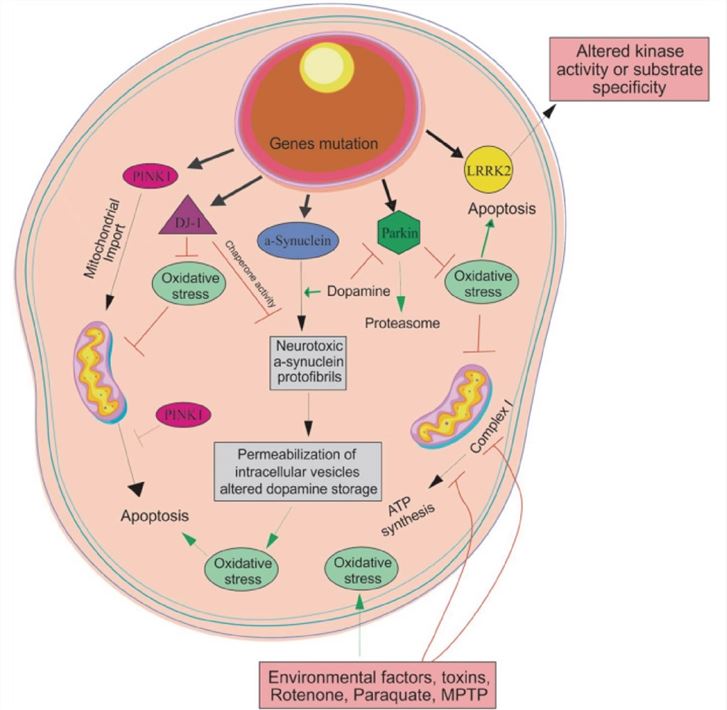
Our promise to you:
Guaranteed product quality, expert customer support.
 24x7 CUSTOMER SERVICE
24x7 CUSTOMER SERVICE
 CONTACT US TO ORDER
CONTACT US TO ORDER
CRISPR/Cas9 System for Research and Treatment of Parkinson's Disease 
Parkinson's disease (PD) is a progressive neurodegenerative disorder commonly that affects elderly people worldwide. Manifestations of PD primarily include dysfunctions of the somatomotor system, such as bradykinesia, rigidity, postural instability, gait dysfunction and tremors. The core of Parkinson's disease is the progressive degeneration of the nigrostriatal dopaminergic pathway with substantial loss of substantia nigra pars compacta (SNpc) neurons and depletion of dopamine (DA). Impairments in nonmotor functions are often accompanied (such as hyposmia, dementia and gastrointestinal alterations) during the disease course.
Genetics Underlying PD
Most cases of PD are sporadic and about 10% are familial in etiology. Familial PD is a genetically inherited form of PD accompanied by multiple disturbances, suggesting that mutations in one or more genes can result in the synthesis of abnormal proteins associated with increased aggregation and/or changes in enzymatic activity. Mutations mediate autosomal-dominant PD in leucine repeat kinase 2 (LRRK2) and α-synuclein (SNCA), while mutations trigger autosomal-recessive PD in parkin, PTEN-induced putative kinase 1 (PINK1), and DaisukeJunko-1 (DJ-1). Other genes involved in the pathogenesis of syndromes with PD-like features include mutations in ATP13A2, DNAJC1, FBX07, PLA2G634, and SYNJ1. It is observed that genes such as eiF4G1, VPS35, and CHCHD2 are linked with sporadic forms of PD with varying degrees of penetrance. Besides, findings of genome-wide association studies (GWAS) have shown an association of at least 41 risk loci with the pathogenesis of PD. These results suggested that SNCA is among the most potent risk loci associated with the sporadic form of PD. However, all genes investigated in monogenic types of PD cannot fully explain the cause of all PD. By employing the promising potentials such as gene modification, gene knocking out/in, transcriptional activation/repression, and epigenetic modification, CRISPR/Cas9 technology paves the way to PD treatment and facilitates the genomic research on the pathogenesis of PD.
 Figure 1. Illustration of the main molecular pathways involved in PD pathogenesis. (Safari F, et al., 2020)
Figure 1. Illustration of the main molecular pathways involved in PD pathogenesis. (Safari F, et al., 2020)
The Applications of CRISPR/Cas9 in PD
Recently developed gene editing technology, Clustered Regularly Interspaced Short Palindromic Repeats (CRISPR) uses the RNA-guided endonuclease CAS9 to cut the double-stranded DNA, which provides the opportunity of editing genes to treat familial PD. Therefore, mutations underlying familial PD can be reversed through stereotaxic injection of RNA-guided editing tool. The Cas9 produces the double-stranded breaks at specific DNA location, triggering the cellular repair process to edit the mutation. The CRISPR-Cas9 technique marks the possibility of manipulation of the germ cell line DNA to get rid of the familial Parkinsonism in future generations. A recent study reported the use of fluorescent labeled markers for editing the mutated PD gene through fluorescence-activated cell sorting (FAC)-assisted CRISPR/Cas9 editing to treat PD associated mutations of α-synuclein gene.
SNCA has been considered as a strong risk locus for sporadic PD. Combined with induced pluripotent stem cell (iPSC) techniques, the genome of human patient-specific hiPSCs was isolated and corrected by ZFN targeting a disease-causing mutation (A53T) in the SNCA gene. Importantly, the repair of the A53T mutation in the patient-derived hiPSCs using CRISPR did not affect the differentiation of TH-positive dopaminergic neurons. Leucine-rich repeat kinase 2 (LRRK2) is another PD-susceptibility gene, with G2019S and R1441C mutations in the gene leading to mitochondrial impairments. Soldner et al. deleted the entire repeat region with CRISPR-Cas9, and reinserted representative alleles for each of the 4 reported repeat-length alleles in hiPSCs. However, after terminal differentiation of hiPSC into neurons, Soldner's team found no cis-regulatory effects on SNCA expression owing to repeat length. On the other hand, Chen et al. used CRISPR-Cas9 to delete the endogenous SNCA gene from human embryonic stem cells (hESCs). After treatment with recombinant α-synuclein preformed fibrils (PFFs), the hESCs that differentiated into dopaminergic neurons exhibited significant resistance to pS129-αSyn-positive protein aggregation, a pathological marker of Lewy body synucleinopathies.
Our CRISPR/Cas9 System Services
CRISPR/Cas9 PlatformCB is committed to providing the most professional and comprehensive genetic editing technology solutions for our clients. To support your projects, we offer a comprehensive custom CRISPR/Cas9 gene editing service from strategy design to final PD model generation.
➢ Establishment of gene-edited cells
➢ Animal models generation of PD by CRISPR/Cas9 system
➢ Analysis of PD-specific pathological changes
If you have any questions, please feel free to contact us.
Related Services and Products
Animal Models
- Conditional Knockout Mouse
- Conventional Knockout Mouse
- Point Mutation Mouse
- CRISPR/Cas9 Knockin Mouse
- Rosa26 Knockin Mouse
Cell Lines
- Point Mutation Cell Line Generation
- HIEF™ Site-Specific Knock-in Cell Line Service
- Fragment Deleted Stable Cell Line
- Gene Editing in Primary T Cells
- Gene Knockout Cell Line Generation
Products
- CRISPR/Cas9 Kits
- Pre-made Knockout Cell Line
- CRISPR Lentiviral Library
- Cas9 Related Plasmids
- Pre-made Cas9 Virus Particles
References
- Safari F, et al. CRISPR System: a high-throughput toolbox for research and treatment of Parkinson's disease. Cellular and molecular neurobiology, 2020, 40(4): 477-493.
- Raza C, Anjum R. Parkinson's disease: Mechanisms, translational models and management strategies. Life sciences, 2019, 226: 77-90.
- Luo J, et al. Utilization of the CRISPR-Cas9 gene editing system to dissect neuroinflammatory and neuropharmacological mechanisms in parkinson's disease. Journal of Neuroimmune Pharmacology, 2019, 14(4): 595-607.
- Artyukhova M A, et al. Interrogating Parkinson's disease associated redox targets: Potential application of CRISPR editing. Free Radical Biology and Medicine, 2019, 144: 279-292.
- Zhu X X, et al. CRISPR/Cas9-mediated generation of Guangxi Bama minipigs harboring three mutations in α-synuclein causing Parkinson's disease. Scientific reports, 2018, 8(1): 1-11.